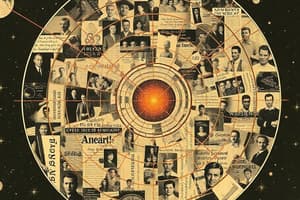Podcast
Questions and Answers
What direction do stars appear to move across the night sky due to Earth's rotation?
What direction do stars appear to move across the night sky due to Earth's rotation?
- West to East
- North to South
- Upward to Downward
- East to West (correct)
At what rate do stars appear to shift sideways across the sky?
At what rate do stars appear to shift sideways across the sky?
- 45 degrees per hour
- 15 degrees per hour (correct)
- 60 degrees per hour
- 30 degrees per hour
Which factor does NOT influence the apparent path of stars as observed from Earth?
Which factor does NOT influence the apparent path of stars as observed from Earth?
- Time of night
- Time of year
- Star's actual brightness (correct)
- Observer's latitude
What is primarily responsible for the apparent movement of celestial objects like stars?
What is primarily responsible for the apparent movement of celestial objects like stars?
How does the observer's latitude affect the apparent motion of stars?
How does the observer's latitude affect the apparent motion of stars?
What is the celestial sphere?
What is the celestial sphere?
What distinguishes apparent motion from true motion in celestial bodies?
What distinguishes apparent motion from true motion in celestial bodies?
Which statement about the daily apparent motion of stars is accurate?
Which statement about the daily apparent motion of stars is accurate?
Flashcards
Apparent Motion of Stars
Apparent Motion of Stars
Stars appear to move across the night sky because of Earth's rotation on its axis.
Cause of Apparent Motion
Cause of Apparent Motion
Earth's rotation on its axis is the primary reason stars appear to move from east to west.
Latitude's Impact on Apparent Motion
Latitude's Impact on Apparent Motion
The observer's latitude on Earth affects the path stars appear to take across the sky.
Constellations and Apparent Motion
Constellations and Apparent Motion
Signup and view all the flashcards
Celestial Sphere
Celestial Sphere
Signup and view all the flashcards
Celestial Sphere and Apparent Motion
Celestial Sphere and Apparent Motion
Signup and view all the flashcards
Apparent Motion
Apparent Motion
Signup and view all the flashcards
True Motion
True Motion
Signup and view all the flashcards
Study Notes
Apparent Motion of Stars
- Stars appear to move across the night sky due to Earth's rotation.
- This apparent motion is from east to west, opposite Earth's eastward rotation.
- The rate of this apparent motion is approximately 15 degrees per hour.
Causes of Apparent Motion
- Earth's rotation drives the apparent movement of celestial objects, including stars.
- Earth rotates from west to east, creating the opposite apparent star motion.
- Earth's tilted axis causes varying day lengths and constellation positions throughout the year.
Factors Affecting Apparent Motion
- Latitude affects star paths. Higher latitudes: more circular paths, lower latitudes: more inclined to the horizon.
- Time of year changes which constellations are visible.
- Time of night changes star positions, as stars also move throughout the night.
Constellations and Apparent Motion
- Constellations, groups of seemingly close stars, also move across the sky due to Earth's rotation.
- Constellation paths vary depending on the observer's latitude.
The Celestial Sphere
- The celestial sphere is a conceptual sphere centered on Earth where stars are projected.
- Star movement on this sphere visually represents Earth's rotation.
- Star positions on the celestial sphere are fixed, while apparent motion is due to our earthly viewpoint.
Apparent vs. True Motion
- Apparent motion is the perceived movement of celestial bodies from Earth's perspective.
- True motion is the actual movement of celestial bodies in space.
- Apparent motion differs from true motion due to our Earth-based vantage point.
Daily and Yearly Apparent Motions
- Stars show daily westward apparent motion as Earth rotates eastward, completing a full circle in 24 hours.
- Constellations show an apparent yearly movement (with minor variations) due to Earth revolving around the Sun.
- Seasonally changing star visibility and positions are part of the yearly apparent motion.
Studying That Suits You
Use AI to generate personalized quizzes and flashcards to suit your learning preferences.




